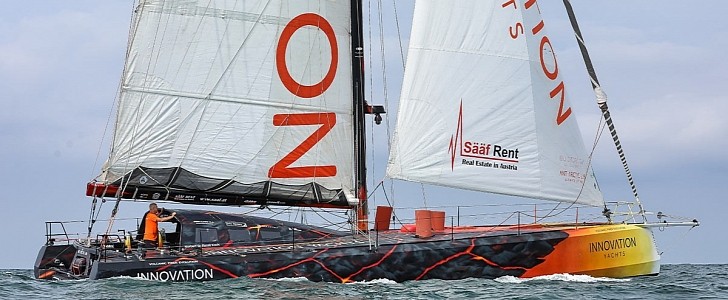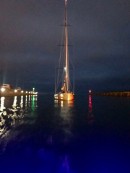On August 15 at 10 am UTC +2, Austrian skipper Norbert Sedlacek Koch embarked from Les Sables de'Olonne, France, on a planned 6-month, 32,000 miles (51,499 km) singled-handed sailing odyssey board a 60-foot (18.28 meters) sailing vessel in pursuit of a world record.
The journey began under scattered cloudy skies, a light breeze, and long swell waves. The ideal conditions upon his departure would not last through his second night at sea. The evening of August 16 brought about 40-knot winds forcing Koch to navigate through rocky seas.
As daylight broke on August 17, Koch's IY Open 60AAL vessel struck something floating in the sea and broke his rudder. He notified his shore team at 2:05 pm that afternoon and chose safety over continuing the challenge with a compromised steering system that he was turning back.
Koch arrived back in Les Sables d'Olonne, France, riding the evening high tide on August 19 under partial sail.
Koch reported his team will assess the condition of the rudder mechanism and plans going forward in the near future.
The ambitious undertaking by the 60-year-old Austrian skipper and Vendee Globe finisher came to an unceremonious and disappointing conclusion for now. Koch's attempt at a world record, single-handed, non-stop, and unassisted journey was to take him through five oceans from the North Pole south to round the Antarctic continent.
His vessel, made from fully recyclable and sustainable materials, was provisioned with 2,400 pounds (1,088 kgs) of supplies to Koch nourished while enduring some of the most brutal sea conditions on earth.
It was a smart decision to abandon the attempt, especially so early on with the proximity to his home port. Losing an effective rudder at sea is a debilitating condition and forces the skipper to either fabricate a makeshift rudder system for steerage or use the trim of the sails to maintain a heading. The journey ended after less than 650 nautical miles of distance covered.
The focus of the attempt, other than the obvious, was to substantiate the viability of utilizing recyclable and sustainable materials in boat building.
As daylight broke on August 17, Koch's IY Open 60AAL vessel struck something floating in the sea and broke his rudder. He notified his shore team at 2:05 pm that afternoon and chose safety over continuing the challenge with a compromised steering system that he was turning back.
Koch arrived back in Les Sables d'Olonne, France, riding the evening high tide on August 19 under partial sail.
Koch reported his team will assess the condition of the rudder mechanism and plans going forward in the near future.
The ambitious undertaking by the 60-year-old Austrian skipper and Vendee Globe finisher came to an unceremonious and disappointing conclusion for now. Koch's attempt at a world record, single-handed, non-stop, and unassisted journey was to take him through five oceans from the North Pole south to round the Antarctic continent.
His vessel, made from fully recyclable and sustainable materials, was provisioned with 2,400 pounds (1,088 kgs) of supplies to Koch nourished while enduring some of the most brutal sea conditions on earth.
It was a smart decision to abandon the attempt, especially so early on with the proximity to his home port. Losing an effective rudder at sea is a debilitating condition and forces the skipper to either fabricate a makeshift rudder system for steerage or use the trim of the sails to maintain a heading. The journey ended after less than 650 nautical miles of distance covered.
The focus of the attempt, other than the obvious, was to substantiate the viability of utilizing recyclable and sustainable materials in boat building.








